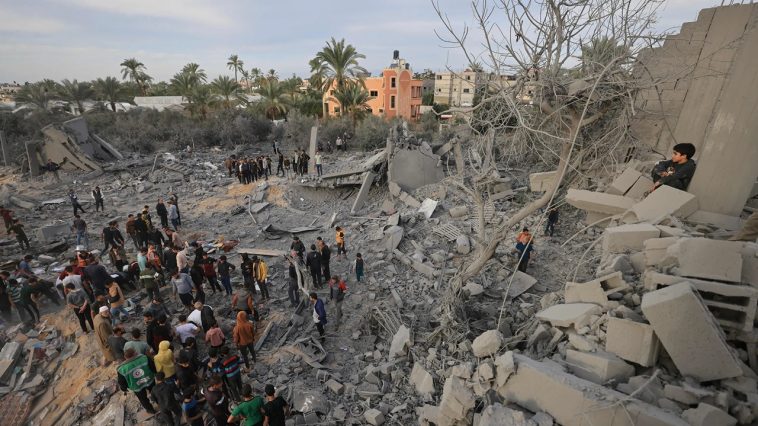LISTEN HERE:
Come Friday morning, a four-day ceasefire between Israel and Hamas will take place; this significant development was declared by Qatar on Thursday.
The cessation of hostilities will take effect from 7 a.m. local time, following which, 13 female and child hostages are slated for release by late afternoon. Majed Al-Ansari, a representative of Qatar’s foreign ministry, confirmed that the list of hostages due for release had been shared with the Israeli intelligence agency, Mossad.
Communications among all intermediary parties carried through until Thursday morning, speaking to the intensity of efforts to bring about this ceasefire. Along with the release of hostages, the Mossad will present an account of Palestinian prisoners to be released to the Qatari authorities. The joint affirmation of these lists will set the stage for the commencement of the release process.
Answering a CNN query, Al-Ansari declined to share any specifics about the route that the soon-to-be-freed hostages would take. The representative emphasized Qatar’s collaboration with the Red Cross and the relevant ‘parties of the conflict’. The Israeli Prime Minister’s office also confirmed receipt of a preliminary list of hostages set for release.
The spokesperson responsible for liaising with the Arab world on behalf of the Israeli Prime Minister, Ofir Gendelman, noted on X that the list of kidnapped individuals has been received by Israel. He added that the pertinent authorities were scrutinizing the list’s details, while maintaining close contact with the affected families.
An Israeli official affirmed, although originally scheduled for Thursday morning, both the pause in conflict and the release of more than 50 women and children among over 230 hostages held in Gaza was postponed. This delay came about just a few hours before the ceasefire was initially planned to begin. The deal that had been discussed earlier included the release of 150 Palestinian prisoners from Israeli detainment.
The soon-to-be-released prisoners, primarily comprised women and children, were identified by Hamas. An element of the deal also involves delivery of humanitarian assistance, medical supplies, and fuel throughout the besieged region, in the form of hundreds of truckloads.
On Wednesday, the Israeli government drew attention to a list of 300 possible Palestinian detainees for release, demonstrating Israel’s readiness for a possible second phase of exchanges. The list consisting of the prisoners’ ages and the charges levied against them. The charges ranged from stone-throwing and ‘endangering regional security’ to affiliating with prohibited terror organizations, incitement, illegal weapon charges, and a couple of accusations relating to attempted murder.
The majority of Palestinian detainees who stand a chance of release are males aged between 16 to 18. This young age bracket fits the definition of ‘children’ as identified by the United Nations, with a few detainees as young as 14 years. Among the detainees are 33 women, as per a CNN count.
In a separate statement, Israel’s National Security Council clarified that the first group of hostages would not be released before Friday. The National Security Council also noted that the agreed temporary pause in hostilities was deferred until Friday.
The council provided assurance that ‘negotiations for the release of hostages were making progress and were ongoing.’ It insisted that the commencement of the release process will follow the original agreement signed by both parties, thereby setting its earliest start on Friday.
In spite of these peace efforts, Israel continued to target militant sites on Thursday, as reported by the IDF. This included operations in northwestern Jabalya, and discoveries of tunnel shafts in a mosque and an agricultural area in Beit Hanoun. The IDF also claimed to have found a significant amount of weaponry and detected a tunnel shaft within a civilian house in the region.
The agreement signifies a major diplomatic stride taken nearly seven weeks after an escalating conflict created a dire humanitarian crisis within the community. With emotions running high, the announcement was warmly welcomed by families of those held captive.
As outlined by Qatar, who played a key role in negotiations, the agreement will result in Hamas releasing hostages in return for the freedom of a number of Palestinian women and children imprisoned by Israel. The ceasefire agreement is also designed to allow the entry of greater quantities of humanitarian and relief aid.
Although the ceasefire can theoretically extend up to ten days, Israeli authorities believe it will likely fall short of this duration. Prime Minister Netanyahu, upon approval of the deal, stated that for every extra ten hostages set free, an additional day of hiatus in conflict would ensue.
Prior to the agreement, only a few hostages were released from a total of 236 held in Gaza, including foreign nationals from across 26 countries.
Israel’s reaction to the hostage situation involved declaring war on Hamas, imposing a blockade on Gaza that restricted the supply of essential commodities like food, water, medicines, and fuel, and executing a relentless air and ground campaign. Reportedly, the ongoing conflict has resulted in the death of approximately 12,700 people in Gaza since October 7.



